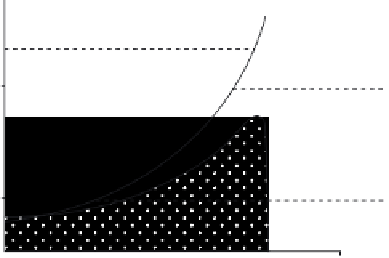Geology Reference
In-Depth Information
Temperature
(°C)
Cold firn
Continuous
permafrost
(tundra)
Alpine (boreal)
forest
-8
Temperate
firn
Discontinuous
permafrost
(tundra and
shrub-tundra)
-1
No permafrost
(steppe-grassland)
2000
500
0
Precipitation
(mm)
Figure 5.8.
Schematic diagram illustrating the relationships between glaciers, permafrost, and
timberline as a function of mean annual air temperature and average annual precipitation. From
Haeberli and Burn (2002).
This empirical method has now been tested elsewhere. In the mountains of Hokkaido,
Japan, the diagnostic BTS value of
2 °C for “permafrost occurrence” disagreed with the
results from DC resistivity soundings (Ishikawa and Hirakawa, 2000). A more promising
fi eld test was undertaken in a mountainous basin in southern Yukon Territory, Canada
(Lewkowicz and Ednie, 2004). Here, the distribution of frozen ground at 200 sites was
compared with modeled BTS values using logistic regression. Analysis showed all catego-
ries of BTS-predicted permafrost were present at statistically signifi cant levels of probabil-
ity but that permafrost occurrence in the area varied markedly over short distances in
response to snow-pack depth. Whether the BTS method is applicable to the arid perma-
frost of the mountain ranges of central Asia, such as the Tien Shan (Gorbunov, 1988a), is
much more problematic.
−
5.4.3. Montane Permafrost of Central Asia and China
The so-called “alpine” permafrost of Central Asia (Qiu and Gorbunov, 1993) combines
many of the characteristics of both alpine and latitudinal permafrost, as described above.
For simplicity, it is referred to as “montane” permafrost. The main difference is that
montane permafrost forms in cold, dry, continental climates. It is also spatially extensive.
According to Qiu Guoqing (in Qiu and Gorbunov, 1993, 75), the total area of high-altitude
permafrost in central Asia is 1,760,000 sq km, of which the vast majority is in the Qinghai-
Xizang Plateau. The main difference from latitudinal permafrost is in terms of its high
elevation and its low latitude.
The majority of montane permafrost occurs in China, with smaller amounts in Mon-
golia, Kazakhstan, and neighboring areas (Figure 5.9). Here, the controls over permafrost
are quite different to those of latitudinal permafrost and, as such, demand further expla-
nation. Central to any discussion is low latitude, high elevation, and relative aridity.
Chinese scientists map permafrost on the Tibet Plateau as being either “predominantly
continuous” (70-80% of area underlain by permafrost) or “isolated” (less than 40-60%
of area underlain by permafrost) (Shi, 1988). Equivalent terms in the North American
literature are “widespread” and “sporadic” permafrost. What is important to stress is that


